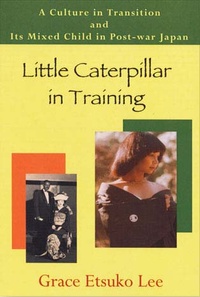In the beginning of summer, I had scheduled to meet with a woman for the first time at a café in Little Tokyo. As a journalist making a living through interviews, it’s not uncommon for me to be meeting somebody new. I could even say that has become a daily routine for me. Yet I was especially looking forward to meeting the woman whom I had promised to see on this day. The reason lies in the book that this woman, Grace Lee, had authored: Little Caterpillar in Training.
Grace was born in Japan in 1950, with the country still healing from the wounds of the war. Her father was an African American from the Virgin Islands working as a civilian engineer for the US military and her mother was the eldest daughter of a wealthy Japanese family running a couple of sawmill businesses in Osaka. She is a mixed race individual of African American and Japanese heritage. From a young age she realized that she would be met with strange looks anytime she set foot outside of her home. She constantly heard from relatives on her mother’s side, “You won’t be able to marry in Japan,” or “You won’t be able to even get a job in Japan.” They made her believe that she was a “freak”.
Still, she was able to enjoy her childhood under the watchful protection of her father. Her father would always tell young Grace, “Never accept limits in your life; nothing can prevent you from doing what you believe you can do.” However, when Grace was 13 years old, she would face a major turning point in her life. Her father suddenly passed away from a stroke. Stricken with grief, her mother decided to take Grace to America in hopes that her mixed-race child would be able to grow up in a more “natural” environment. However, even the African-Americans, whom her mother refers to as “Your People,” had alienated the comparatively fair-skinned Grace. As she painfully came to realize that they were not “My People,” she decided that there was no place for her in Japan or America, and became determined to live life in order to “become her own person.”
After someone had introduced me to Little Caterpillar in Training, I had the book sent to me from Grace herself, and read the book from cover to cover in about two hours. At 140 pages long, it is not a very thick book, nor is it especially thin. But I finished the book so quickly because I was deeply pulled into the retrospective tale of her childhood as an “Ugly Duckling.” Just by reading her words, I was able to visualize her childhood environment, her family, her first love—all as if I were watching a movie in my mind.
Contrary to present day Japan, wherein the younger generation sees a mix of African heritage as a “cool” thing, this young heroine was born in post-war Japan, during a time in which “discrimination and prejudice” were deeply rooted among the Japanese, and I noticed myself rooting for her as the story progressed. The historical backdrop and family environment that people are born into are not coincidences—they are inevitabilities. Overcoming the difficulties and the challenges of unequal treatment is what we call our “growth as human beings.”
This message is strongly felt throughout Little Caterpillar in Training. It will surely provide courage to anybody feeling stuck on the path of life.
I remember back in the day, there was a novel called “Ningen no Shomei (Proof of the Man)” which was also made into a movie. In the story, there is a young man born of an African father and Japanese mother. The sorrow that he feels in his quest to find a place of belonging is well expressed, but this story is strictly fictional. On the other hand, Little Caterpillar is based on the real-life experiences of Grace. This book is perhaps the first of its kind that depicts the realities of mixed race children in an emotionally moving narrative. In fact, there were several scenes that I struggled to read without shedding tears.
Yet the Grace that I met at the café was completely different from the type of person I was expecting, in a good way. There were no telling signs of a girl who suffered through her childhood. She was endlessly cheerful and bright. Surely she had experienced various hardships, even after coming to America at 14 years old; but here was a person who overcame it all, now working as a consultant between Japan and America—a wonderful woman, full of confidence and kindness. In her private life, she married a Hungarian man, and has a grandchild (with blond hair and blue eyes). She said she now spends her days traveling back and forth between her home in Arizona and her mother’s home in California.
Little Caterpillar in Training is about a young girl who grows up believing she is an ugly caterpillar, and returns to Japan 10 years later to attend her grandmother’s funeral as a full-grown butterfly. The story ends as Grace learns that the discriminatory tendencies of the Japanese had been watered down with the passing of time. However, since the story jumps from her life as a high school student in America to the final scene in Japan, I was left wondering, “What kind of experiences did Grace have during the time in between?” I decided to ask Grace in person.
“I’m actually working on part two right now; it’s going to include some very provocative material. I guess we’ll have to give it an adults-only rating,” she said, with a mischievous smile.
* Website related to Little Caterpillar in Training: http://littlecaterpillar.com/
* * *
Bridging Two Cultures: Grace Etsuko Lee Discusses her Personal Experiences in Japan and the U.S.
November 13, 2010 at 2 pm
Tateuchi Democracy Forum of the Japanese American National Museum
Grace Lee will share her stories from her new book, Little Caterpillar in Training: A Culture in Transition and Its Mixed Child in Post-war Japan, a unique and humorous personal story of growing up in Japan as well as in the United States as a bi-racial child.
For more information: janm.org/events/tateuchi/
© 2010 Keiko Fukuda







